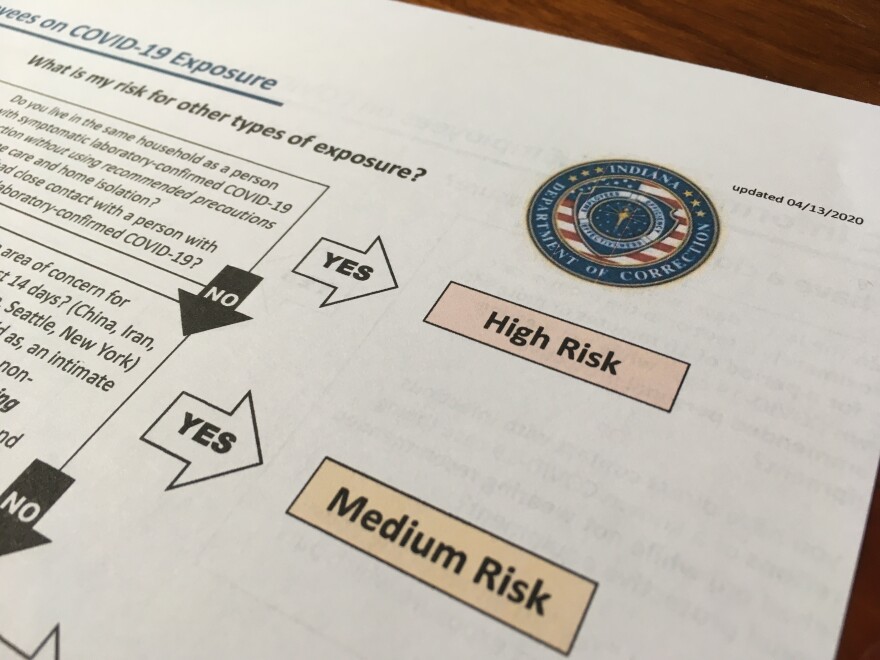An Indiana Department of Correction policy may increase the spread of coronavirus in prisons by requiring “high risk” and “medium risk” staffers to report to work, Side Effects has learned.
According to internal documents, Indiana broke with the Centers for Disease Control and Prevention’s guidance for prisons, which says that staff should self-quarantine for 14 days after close contact with an infected person. By mid-April, the state required prison employees without symptoms to come to work — even if they live with someone who tests positive for COVID-19.
Health experts say the policy could allow staff to introduce the virus into prisons, which are especially vulnerable to disease outbreaks.
“It’s very dangerous,” says Leonard Rubenstein, a Johns Hopkins University professor who researches human rights and public health. “Enabling someone to come in when there's a high risk of contagion from that person is, to me, irresponsible.”
The Department of Correction says it changed its policy to align with CDC guidance for “critical workers.” It also says that correctional facilities “apply the guidelines as dictated by local needs and applicability.”
The CDC issued guidance for correctional facilities in March because inmates “live, work, eat, study, and recreate within congregate environments, heightening the potential for COVID-19 to spread once introduced.” The guidance also points out that staff may introduce the virus to a facility as they move between the community and a facility.
But since the pandemic began spreading through Indiana prisons, inmates have reported lapses in protocols to prevent the spread of the coronavirus. They’ve said social distancing is impossible, and that masks and hand sanitizer are unavailable. They’ve said that prisoners with COVID-19 symptoms are not always isolated from other prisoners — in some cases, even after they beg for medical attention.
The Department of Correction has maintained that it follows its own pandemic response plan along with CDC guidelines for correctional facilities. The department’s website points to those guidelines, and an April 6 letter from commissioner Rob Carter to prisoners’ families states that the department's efforts are “closely aligned” with the CDC’s recommendations.
However, the department modified its stance on employee self-quarantine shortly after that letter, requiring employees without symptoms to come to work. Health experts who spoke with Side Effects say the change is risky.

“If someone in your house gets it, you're a lot more likely to get it yourself, even if you remain asymptomatic during that time,” says Shandy Dearth, who heads undergraduate epidemiology at Indiana University’s Fairbanks School of Public Health. “Some people can be perfectly healthy and it looks like they're still spreading it.”
Dearth points out that 44.8% of people in Indiana who tested positive for COVID-19 reported no symptoms, according to preliminary findings of a recent study from the Fairbanks school and the Indiana State Department of Health. Some people may not notice mild symptoms, and people can also be contagious before symptoms begin, in what’s known as presymptomatic spread.
“People should have the flexibility to stay home when needed, otherwise you're just risking spreading [the coronavirus] throughout the facility,” Dearth says.
The department updated its policy on April 13. That day, the agency reported 48 staff and 27 prisoners had tested positive across seven facilities. By June 10, at least 317 staff and 694 prisoners had tested positive, and inmates had been found with COVID-19 in seven more facilities.
Nineteen prisoners and two prison employees have died of suspected or confirmed COVID-19.
The Department of Correction declined an interview request, but answered questions via email. A spokesperson said the policy change occurred as knowledge about the virus evolved. “It is important to keep in mind the guidelines offered by the CDC are just that: guidelines,” he wrote.
Department employees, like other similar state workers, are eligible for two weeks of paid leave time if they experience COVID-19 symptoms or if a health care provider recommends they self-quarantine. The spokesperson wrote that some administrative staff are able to work remotely.

While moving away from the CDC’s prison guidelines may increase the danger to inmates and staff, prisons also need a certain number of staff to operate, says Dr. Marc Stern, former medical director of the Washington state prison system.
“There’s a tradeoff. What they’re deciding may make sense — it may be justifiable,” he says. “Or it may not be.”
Stern points out that prisons have another way to help manage the coronavirus: They could let some prisoners out early, such as the elderly, those who have underlying health conditions or those who are close to being released. Doing so would make prisons and jails safer for everyone, he says.
While many states have taken such steps, Indiana Governor Eric Holcomb has refused repeated calls to do that, leaving decisions about early release to local courts.
“I’m not sure I understand that decision on the part of the governor,” says Stern. “Jails and prisons need to be downsizing.”

Rubenstein, the Johns Hopkins professor, says the Department of Correction may face legal battles over its decision to break from the CDC guidance for prisons.
The U.S. Supreme Court has ruled that prison officials may violate 8th Amendment protections against cruel and unusual punishment if they show “deliberate indifference” to a prisoner’s medical needs — if they’re aware of a significant risk, but disregard it.
Requiring someone to work at the prison even after exposure to the coronavirus, when they could pass it to vulnerable inmates, may amount to deliberate indifference, says Rubenstein.
“It's very clear what the guidance is — you should not come to work,” he says. “Of all places to come to work, a prison seems the most dangerous.”
This story was produced by Side Effects Public Media, a news collaborative covering public health. Jake Harper can be reached at jharper@wfyi.org.






